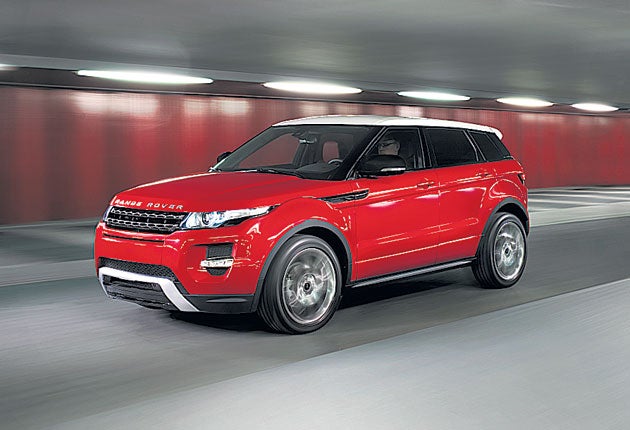Next year’s hottest drive?
Concept cars tend to be watered down when it comes to production – but the latest Range Rover bucks the trend

A couple of years ago, Land Rover was going through a sticky patch. Ford, then the company’s owner, decided to simplify its operations and divest itself of most of its luxury brands, which also included Volvo, Aston Martin and Jaguar. Land Rover and Jaguar eventually ended up with the Indian group Tata. At the same time, sentiment turned strongly against 4x4s, the result of growing environmental concerns and rising oil prices.
But if Land Rover faced a very strong headwind, it still had two big things going for it; superb products and one of the best brands. One immediate fix was to improve the economy of the existing cars. The big Land Rovers and Range Rovers received better diesel engines as part of comprehensive mid-life updates while the smaller Freelander got a fuel-saving stop-start system. The Freelander is also being made available in two-wheel drive form, a move that would previously have been considered impossible for a leading maker of 4x4s. Now the savings that can be made in terms of economy and emissions make it impossible to avoid.
Things are already on the up again but now we’re also seeing the first evidence of what the Land Rovers of the future, fully adapted to today’s more eco-conscious times, will look like. Range Rover used to be the name of Land Rovers most prestigious car; now it is the brand for a whole parallel range of up-market vehicles, and the company will soon introduce the Evoque, the smallest car ever to carry a Range Rover badge. It’s about the size of the Land Rover Freelander; in fact the Freelander’s underpinnings were the starting point in the development of the Evoque but were very heavily modified as the design of the new model advanced.
The shape of the Evoque, though, is taken from Land Rover’s LRX concept car, first seen at the 2008 Motor Show. Produced under the leadership of the company’s design director, Gerry McGovern, the LRX took many traditional Range Rover design elements, such as the grille and the “floating” roof but cleverly remixed them into a form that was curvier, sleeker and sportier. The results were stunning; the only question was whether Land Rover could really put the LRX into production without sacrificing its essence. If cars are to be sold to the public, they have to meet a catalogue of regulations, many of which determine the position and performance of different parts. The people who buy those cars expect to be able to get into them without performing contortions, and to enjoy a decent field of view and generous headroom, requirements that are hard to reconcile with the low-roofed look of your average concept car.
There is a long history of dramatic concept cars being watered down into slightly disappointing production cars, one from which McGovern was keen to break free, perhaps not least because of the grumbles Land Rover itself faced a few years back when its Range Stormer concept morphed into the handsome but less exciting Range Rover Sport. And you’d have to say he’s succeeded, because apart from a few concessions to practicality and regulation such as larger door mirrors and revisions to the detailing of the nose, the three-door version of the Range Rover Evoque really is pretty much a 1:1 copy of the LRX. That’s the result, apparently, of exceptionally close working between the members of McGovern’s team and their engineering counterparts.
The Evoque was given a warm reception when it was launched in three-door form at the Paris Motor Show in October – although I thought I must have misheard when Land Rover executives referred to it as a coupé at their press conference. But it was no mistake and that description, as well as being justified by the Evoque’s sporty appearance was a clue that something else might be on the way. Because a few weeks later I found myself in the inner sanctum at Land Rover’s impressive engineering centre at Gaydon in the South Midlands, as part of a small group to be granted an early look a second Evoque, a previously unannounced five-door sister to the coupé. If anything the five-door is cleverer in execution than the three door; the subtle alterations that have been implemented in order to make it slightly roomier, such as a gently raised roof, have all been incorporated without upsetting the balance or beauty of the original shape.
Will the Evoque be a success? I’m going to stick my neck out and say yes – and a big one too. The agility of the two-wheel drive eD4 version of the Freelander provides an encouraging clue to the on-road behaviour of the Evoque, which will be available with a similar drivetrain but a fancier suspension set-up. My understanding is, that for all its cute urban looks, the Evoque doesn’t, in 4x4 form, give much, if anything, away in terms of off-road ability. Unlike the Freelander, the Evoque will also be available with a petrol engine, in this case a strong 240 horsepower two-litre from Land Rover’s former parent, Ford. But it’s really those looks and the Range Rover name that will sell this car – and boost Land Rover’s bottom line. The Evoque is in the same size and weight bracket as the Freelander and uses many familiar components, but its prices will start at about £30,000, rather than the Freelander’s £22,000. And Land Rover reckons that the Evoque will be its biggest seller, bigger even than the Freelander, which finds about 60,000 customers a year. If you’re wondering what the hottest car of 2011 will be, I think you may be looking at it.
Join our commenting forum
Join thought-provoking conversations, follow other Independent readers and see their replies
Comments
Bookmark popover
Removed from bookmarks